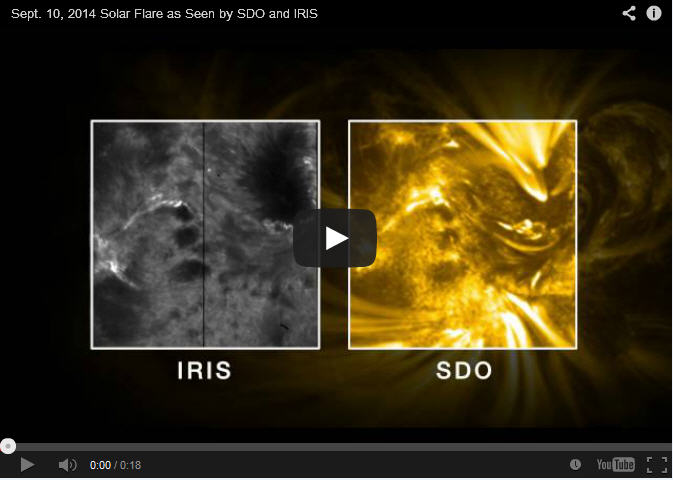

Two views of an X-class solar flare on Sept. 10, 2014. IRIS focuses on the lower regions of the sun's atmosphere, while the SDO imagery shows a region that is hotter and typically slightly above that.
Image Credit: NASA/LMSAL/Wiessinger
The movie shows IRIS imagery focused in on material at around 60,000 Kelvin (107,500 F), which highlights a low level of the sun's atmosphere, called the transition region. IRIS can zoom in on the transition region with unprecedented resolution.
The imagery on the right side is from SDO. The movie shows material at about 600,000 Kelvin (1,080,000 F), which highlights material typically higher up in the atmosphere in what's called the corona, (Although in a dynamic event such as a flare, hot and cold material often occur at the same heights.)
The IRIS video clearly shows a dark sunspot in the upper right, a magnetically complex region observed on the sun's surface. SDO, on the other hand, shows what's happening above that – giant magnetic loops rise up off the surface.
As the flare begins, crisp bright lines show up moving across the IRIS data, showing where material begins to be heated with the onset of the flare. Some of this imagery appears in the SDO side as well, but so do many other features and brightenings. It is only by comparing the two movies that one can tease out what's happening at the lower temperatures – likely to be in the lower atmosphere – versus what is happening higher up.
IRIS must commit to pointing at certain sections of the sun at least a day in advance, so catching these eruptions in the act involves educated guesses and a little bit of luck. So far, IRIS has seen two X-class flares, and numerous M-class flares – X-class flares are the strongest flares, while M-class are a tenth as strong. These observations have offered some of the first comprehensive observations of what happens in the transition region during a flare.
Lockheed Martin’s Solar & Astrophysics Laboratory in Palo Alto, California, designed and manages the IRIS mission. NASA's Ames Research Center in Moffett Field, California, provides mission operations and ground data systems. NASA's Goddard Space Flight Center, in Greenbelt, Maryland, manages the Explorer Program for NASA's Science Mission Directorate in Washington, D.C.
Related Links
For more information about IRIS, visit:
For more on the Sept. 10, 2014 flare, visit:
http://www.nasa.gov/content/goddard/significant-flare-surges-off-the-sun/
To download the high-resolution video, visit:
http://svs.gsfc.nasa.gov/vis/a010000/a011600/a011651/
Karen C. Fox
NASA's Goddard Space Flight Center, Greenbelt, Md.












